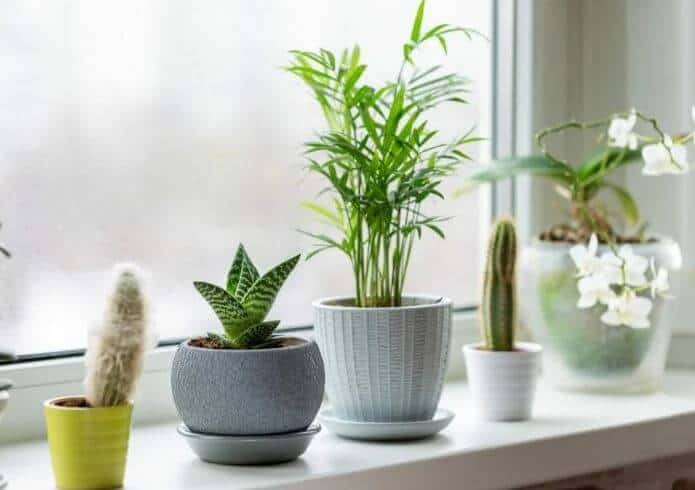Last Updated on June 4, 2023 by a Friendly Gardener
When using south-facing windows plants receive significant amounts of direct sunlight and this can be problematic. Often plants that are randomly placed in these windows end up sunburned, dropping leaves, and shriveled. While some plants do indeed love generous amounts of direct sunlight, not all plants can manage direct light which is often harsh.
For sun-loving plants, south-facing windows are optimal if there is sufficient protection against scorching as window glass can amplify both the light and heat. Before you position a plant in a south-facing window, observe the amount of light provided, the humidity level, and the environmental temperature in the vicinity of the window. A humidity meter and thermometer can help. It’s important to identify how much warmer the window and immediate vicinity is.
Protection during the summer season will most likely be necessary. This can be done by using a sheer curtain to prevent scorching and sunburn. A curtain will also help when the heat becomes intense. If you need less light for your plants use blinds or darker curtains as protection. Also, consider insulating your plant’s roots through double-potting.
Watering plants in south-facing windows should be limited to the morning or the evening and not when the sun and heat are most intense.
Best Plants for a South-Facing Window
Many flowering plants will perform well in south-facing windows as they require quite a bit of energy to bloom or produce fruit. Here are some of our favorites for bright, sunny south-facing windows.
1. Cacti
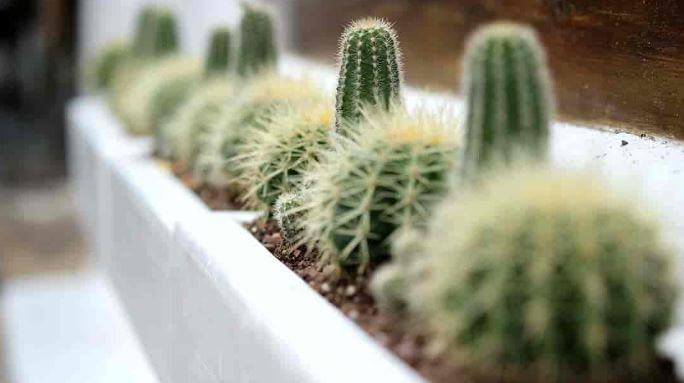
Cactaceae or Cacti is a logical choice for a south-facing window. These predominantly desert plants belong to a group that boasts more than 2000 known species. There is no better plant than a cactus if heat is extreme and drought is more common than a cactus. While cacti do not have typical foliage, they are extremely efficient in storing water for droughts. Their desert environments offer little to no shelter or shade and their spines function as a mechanism to contrast this lack of shade. Many varieties of cacti produce lovely and vividly-colored blooms in white, yellow, orange, pink, and red when they receive adequate sunlight. Provide full sun in your south-facing window without filtering. Water sparingly and make sure the soil bed, formulated for cacti, dries completely before repeating.
2. Hibiscus
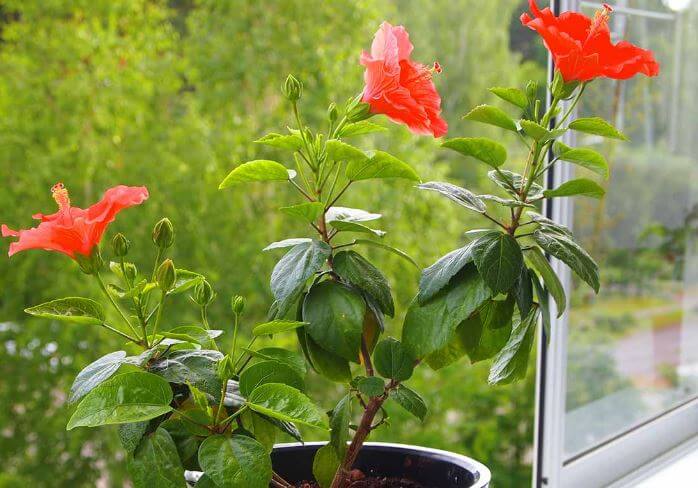
The Hibiscus Rosa-Sinensis is a stunning window dresser featuring big, bold, and colorful flowers. If you love flowers, this plant deserves consideration. This tropical native can bloom year-round in the right conditions and require generous amounts of direct sunlight. To care for a hibiscus plant, soak it regularly allowing excess water to drain. Do not permit the soil bed to become soggy, so after each watering allow the soil bed to dry before watering anew. This plant will require pruning to maintain its shape and it will benefit from regular fertilization with a potassium-rich fertilizer. The hibiscus produces flowers in white, yellow, orange, pink, and red.
3. Jasmine
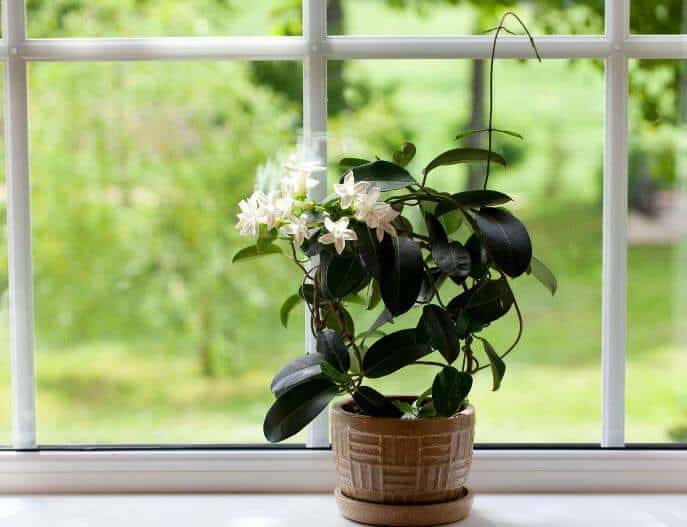
Jasinum or jasmine plants are well-loved for their fragrant petite white flowers, although blossoms may occasionally be pink. Jasmine plants prefer warm environments and sunny spots to grow in. However, to protect blooms, exposure to sunlight should be filtered. These plants do require generous amounts of water to ensure blooming. Soil beds need to be consistently moist; they should not be allowed to dry out. Jasmin plants also benefit from higher humidity levels, so you can mist regularly, use a pebble tray underneath the plant pot or a space humidifier unless you have a south-facing window in your bathroom where humidity levels are naturally higher.
4. Money Tree
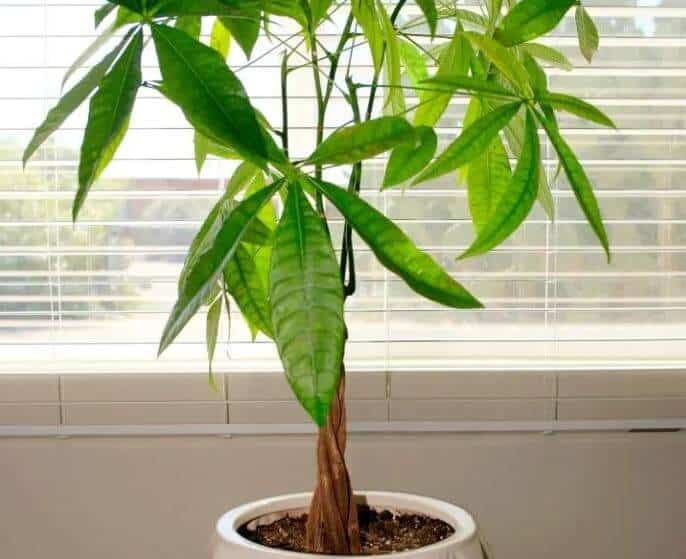
Among south-facing window plants, the delightful Pachira Aquatica, also known as the Money Tree plant, prefers a mix of filtered and direct sunlight exposure. They also love warm environments. These two characteristics make them an obvious choice for south-facing windows, ideally furnished with a sheer curtain. Because the Money Tree grows well in sunlight, it will need to be rotated otherwise it will develop more on the side left facing the window. You can rotate with each watering. A Money Tree plant does best when watered weekly or bi-weekly depending on the climate and indoor temperature. Soak your plant, allowing excess water to drain, and then allow the soil bed to dry out completely before watering again. These lovely trees also prefer higher humidity levels, so misting, pebble trays, space humidifiers, or receptacles with water placed nearby will satisfy this need.
5. Ponytail Palm

Botanically identified as the Beaucarnea Recurvata, the popular Ponytail Palm boasts a large trunk with a wild hairdo so to speak made up of lots of skinny leaves sprouting in all directions. This mini palm tree is easy to take care of as it requires care like that of succulents. Ponytail palms can be placed in shallow pots using soil that is formulated for succulents or cacti. It has a slow growth rate and will require repotting every two to three years. It manages well in both direct and filtered sun. Watering should be conducted only when the soil bed has dried out as this plant can store water in its trunk. For a plant full of personality, the Ponytail is an ideal choice.
6. String of Pearls

The Senecio Rowleyanus, popularly called the String of Pearls Plant is an unusual succulent with a trailing growth habit. It is best cultivated in a hanging basket or from a high perch to appreciate its unique appearance, so find a way to hang this beauty in your south-facing window. They will burn if exposed to direct harsh sunlight, so sheer curtains or your method for hanging the plant should provide a minimum of protection. Soil should be formulated for succulents and cacti and be coarse in texture to ensure drainage. The String of Pearls plant does not require much watering, do so sparingly. Another advantage to this plant is that it is very easy to propagate from stem cuttings.
A Final Thought
When cultivating plants indoors and especially plants for south-facing window, light exposure can be quite challenging. Understanding the natural habitats of the plants you select and help you choose the ideal spot and reward you with a flourishing and vibrant indoor garden all year long.

